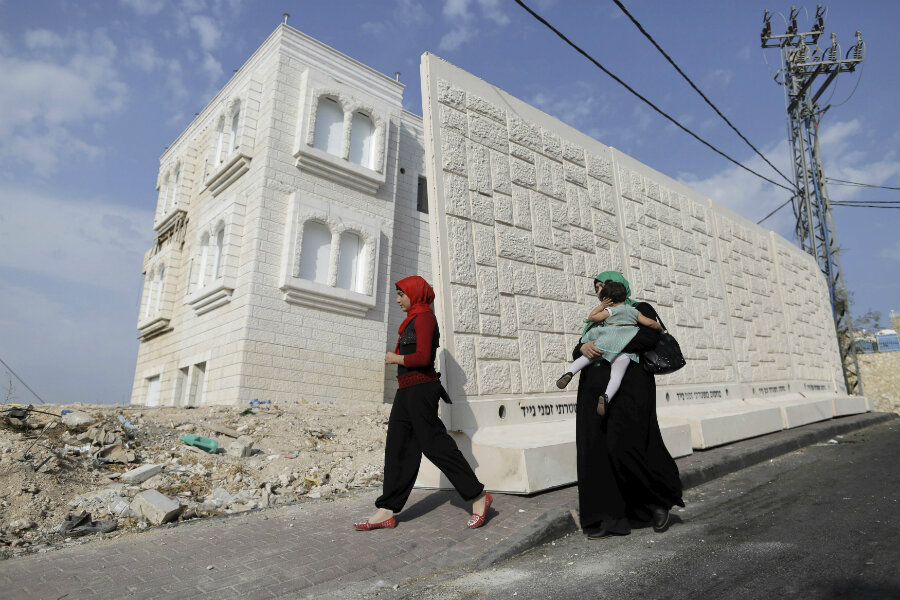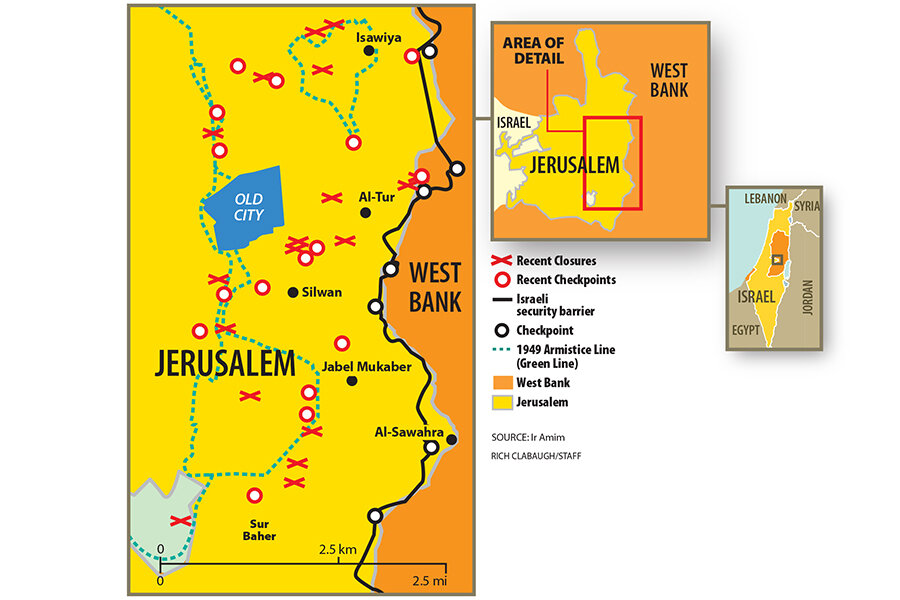Jerusalem violence: How redividing city poses dilemma for Israel, Palestinians
Loading...
| Jerusalem
The southern Jerusalem neighborhoods of Armon Hanatziv and Jabel Mukaber straddle a border that has remained open and mostly unmarked ever since Israel captured the Arab eastern half of the holy city nearly five decades ago.
But over the last three weeks, a wave of Palestinian stabbing and shooting attacks has led to a wider outbreak of deadly violence. In response, Israeli security forces have put in place in the last week an array of police-manned checkpoints and concrete barriers between neighborhoods like Palestinian Jabel Mukaber and Israeli Armon Hanatziv.
The prospect of a redivided Jerusalem presents both sides in the conflict with a dilemma that pits ideology against reality.
Israel’s right-wing government is ideologically committed to a united Jerusalem even as it blocks off sections and lays down signposts for a future political division. Palestinians, meanwhile, want sovereignty over the eastern half as the capital of a future state, but decry the impact of the separation on people’s lives.
A new obstacle
For Palestinian Jerusalemites who have been accustomed to decades of open access to anywhere in Israel, even as their countrymen in the West Bank were stopped at roadblocks, the new barriers are a major inconvenience and seen as collective punishment.
“It’s an apartheid wall. They want us to stay in our home and not go to school,” says Lureen Tayem, a 15-year-old from Jabel Mukaber, as she stands next to a concrete barrier and new sections of wall just a city block from Armon Hanatziv. The intersection, a flashpoint for rock and Molotov cocktail throwing, is manned by Israeli border police.
“If they put up hundreds of walls we will still be here,” she says. “We will stay in this land.”
The official Palestinian position is that Jerusalem should remain an open city in which political sovereignty should be divided along the line that physically separated the city before 1967.
According to Ir Amim, an Israeli non-profit that supports an open Jerusalem that’s a capital for two states, Israel in the last week has erected 35 barriers and checkpoints along the old Green Line – from the neighborhood of Isawiya in the north to Sur Baher in the south. Barriers have choked traffic in and out of Palestinian neighborhoods – making it hard for residents to reach jobs – but the closure is far from hermetic.
In addition, Israel has deployed thousands of border police reinforcements to patrol between the two halves of the city. On one street, patrol cars pass every few minutes, stopping young Palestinian men in cars and on the sidewalks for inspections.
Saeb Erekat, the longtime Palestinian negotiator, has decried the Israeli moves, saying they are turning the Palestinian districts of the city into a “military bunker.”
City divided without the barriers
The moves came after two young men from Jabel Mukaber killed two Israelis on a commuter bus making its way through Armon Hanatziv, on Oct. 13. Outraged, Jerusalem Mayor Nir Barkat – an outspoken opponent of any Israeli territorial concessions in Jerusalem – called for Arab neighborhoods to be sealed off.
But for many Israelis, that symbolizes a redivision of Jerusalem.
Ever since Israel destroyed the fences and walls that divided the city between Israeli and Jordanian control between 1949 and 1967, Palestinians in the city were integrated into Israel’s social welfare system and employment market – a boost to their standard of living.
But the separation persisted: roads were neglected, building development stymied, and not enough schools were built. Standing at the barrier dividing the well-planned Armon Hanatziv and haphazard Jabel Mukaber, the physical contrast is clear.
Security versus ideology
For Armon Hanatziv residents like Molly Livingstone, an online content creator, the new barriers help provide a sense of security. She laments that Palestinians and Israelis no longer meet in Armon Hanatziv’s baby care center or play on the same soccer pitch, but accuses Arab neighbors of openly celebrating the kidnapping and murder of three Israeli teens in the summer of 2014.
“[The Palestinians] are not fenced in any more than we are stuck in our houses in fear,” she says. “I can walk out of my house and be stabbed, and they walk out of their house and be searched.”
But erection of the barriers has sparked a debate among Israeli politicians. While opposition leader Isaac Herzog said he supports a closure on Palestinian neighborhoods, others on the left have ridiculed Prime Minister Benjamin Netanyahu, who has championed a united Jerusalem, for redividing the city.
When slabs of wall went up between Jabel Mukaber and Armon Hanatziv this week, right-wing ideologues in Mr. Netanyahu’s cabinet protested. One minister from his Likud party reportedly said it would give a “prize to terror.”
Indeed, Israeli experts say that even though the barriers give the police the ability to check for potential attackers, the barriers carry little security value and are more to show Israelis like Ms. Livingstone something is being done.
An economic and social barrier
“If you are a resident of Jabel Mukaber, or Isawiya, you know your way in and out,” said Amos Harel, a military analyst for the newspaper Haaretz, in a briefing to reporters. “If someone blocks your car, there are five or six ways to get around it if you want to carry out an attack.”
Beyond it being physically impractical to separate the city, analysts say there’s an economic symbiosis between Arab and Jewish regions of Jerusalem. Though they live separately, Palestinians use the banks and health services in Armon Hanatziv, while Jews come to Jabel Mukaber to get groceries and employ drivers and laborers.
“Every morning, 40,000 Palestinian Jerusalemites cross the line and come to work in Jewish Jerusalem as hotel employees, medical staff, and drivers,” says Eliezer Yaari, a former Israeli journalist who wrote a book about meeting Palestinian Jerusalemites.
“The Palestinians are integrated into the city.… If you want to build enclaves for Palestinians in Jerusalem, and you think you are going to maintain economic life and some kind of social fabric, this is a joke.”
Checkpoints are 'like an anesthetic'
At the site of the bus attack in Armon Hanatziv, about a dozen or so Jews wave flags, play patriotic music, and shout over a loudspeaker.
Watching the demonstration from across the street in his halal food market in Jabel Mukaber, Nasser Rajbi gripes derisively that the current dispute “is a game” between Netanyahu and Palestinian Authority President Mahmoud Abbas.
While checkpoints might help tamp down unrest, he says, the calm would not last for long as long as the political leaders fail to come up with a solution for their conflict.
“Checkpoints don’t bring me respect or calm,” he says. “They’re like an anesthetic. You take it before an operation. But eventually you wake up.”









